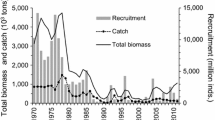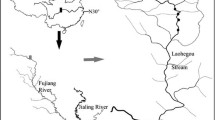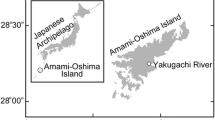Abstract
Information on survival and growth during the early life stage is essential to understand the mechanism of interannual variations in fish recruitment. Chub mackerel Scomber japonicus is a commercially important pelagic fish widely distributed in the northwestern Pacific. Its catch showed large fluctuations with changes in distribution and migration under climate change and strong fishing. We determined the hatch dates and growth rates of young-of-the-year of chub mackerel through otolith microstructure using samples collected in the Oyashio water in autumn 2018. Results show that the ages of young chub mackerel ranged between 120 and 180 d, and the estimated hatch date lasted from mid-January to late May with a peak from mid-March to mid-April. Average otolith daily increment width during the early life stages (from hatching to 25 d) showed an increasing trend. Chub mackerel grows slowly in the first 10 d, and then grows faster during the 10th to 25th d. Three groups with dissimilar growth histories and migration routes were identified using unsupervised random forest clustering analysis, but all eventually converge on the same nursery ground. The faster growth of young-of-the-year chub mackerel leads to better recruitment due to the hypothesis of growth-dependent mortality. Most chub mackerels hatched in March and April, the spawning period is longer and earlier, which could lead to strong year classes. These findings on population composition and life history traits of young-of-the-year of chub mackerel provide valuable information on its recruitment processes during the period of stock recovery.
Similar content being viewed by others
Data Availability Statement
The datasets generated during and/or analyzed during the current study are available from the corresponding author on reasonable request.
References
Breiman L. 2001. Random forests. Machine Learning, 45: 5–32, https://doi.org/10.1023/A:1010933404324.
Brophy D, Danilowicz B S. 2002. Tracing populations of Atlantic herring (Clupea harengus L.) in the Irish and Celtic Seas using otolith microstructure. ICES Journal of Marine Science, 59(6): 1305–1313.
Campana S E, Thorrold S R. 2001. Otoliths, increments, and elements: keys to a comprehensive understanding of fish populations? Canadian Journal of Fisheries and Aquatic Sciences, 58(1): 30–38.
Clausen L A W, Bekkevold D, Hatfield E M C et al. 2007. Application and validation of otolith microstructure as a stock identification method in mixed Atlantic herring (Clupea harengus) stocks in the North Sea and western Baltic. ICES Journal of Marine Science, 64(2): 377–385.
FAO. 2016. The State of World Fisheries and Aquaculture 2016. New York: FAO. p.200.
Go S, Lee K, Jung S. 2020. A Temperature-Dependent Growth Equation for Larval Chub Mackerel (Scomber japonicus). Ocean Science Journal, 55: 157–164.
Guo C Y, Ito S I, Kamimura Y et al. 2022. Evaluating the influence of environmental factors on the early life history growth of chub mackerel (Scomber japonicus) using a growth and migration model. Progress in Oceanography, 206: 102821.
Higuchi T, Ito S I, Ishimura T et al. 2019. Otolith oxygen isotope analysis and temperature history in early life stages of the chub mackerel Scomber japonicus in the Kuroshio-Oyashio transition region. Deep Sea Research Part II: Topical Studies in Oceanography, 169–170: 104660.
Kamimura Y, Takahashi M, Yamashita N et al. 2015. Larval and juvenile growth of chub mackerel Scomber japonicus in relation to recruitment in the western north Pacific. Fisheries Science, 81(3): 505–513.
Kanamori Y, Takasuka A, Nishijima S et al. 2019. Climate change shifts the spawning ground northward and extends the spawning period of chub mackerel in the western north Pacific. Marine Ecology Progress Series, 624: 155–166, https://doi.org/10.3354/meps13037.
Kandaswamy K K, Chou K C, Martinetz T et al. 2011. AFP-Pred: a random forest approach for predicting antifreeze proteins from sequence-derived properties. Journal of Theoretical Biology, 270(1): 56–62.
Kawai H, Yatsu A, Watanabe C et al. 2002. Recovery policy for chub mackerel stock using recruitment-per-spawning. Fisheries Science, 68(5): 963–971.
Liaw A, Wiener M. 2002. Classification and Regression by randomForest. R News, 23(23): 18–22.
Murayama T, Mitani I, Aoki I. 1995. Estimation of the spawning period of the Pacific mackerel Scomber japonicus based on the changes in gonad index and the ovarian histology. Bulletin of the Japanese Society of Fisheries Oceanography (Japan), 59(1): 11–17. (in Japanese)
Nakamura M, Yoneda M, Ishimura T et al. 2020. Temperature dependency equation for chub mackerel (Scomber japonicus) identified by a laboratory rearing experiment and microscale analysis. Marine and Freshwater Research, 71(10): 1384–1389.
Sassa C, Tsukamoto Y. 2010. Distribution and growth of Scomber japonicus and S. australasicus larvae in the southern East China Sea in response to oceanographic conditions. Marine Ecology Progress Series, 419: 185–199.
Seligson D B, Horvath S, Shi T et al. 2005. Global histone modification patterns predict risk of prostate cancer recurrence. Nature, 435(7046): 1262–1266.
Shi T, Horvath S. 2006. Unsupervised learning with random forest predictors. Journal of Computational and Graphical Statistics, 15(1): 118–138.
Shiraishi T, Ketkar S D, Katoh Y et al. 2009. Spawning frequency of the Tsushima current subpopulation of chub mackerel Scomber japonicus off Kyushu, Japan. Fisheries Science, 75(3): 649–655.
Sogawa S, Hidaka K, Kamimura Y et al. 2019. Environmental characteristics of spawning and nursery grounds of Japanese sardine and mackerels in the Kuroshio and Kuroshio Extension Area. Fisheries Oceanography, 28(4): 454–467.
Taga M, Kamimura Y, Yamashita Y. 2019. Effects of water temperature and prey density on recent growth of chub mackerel Scomber japonicus larvae and juveniles along the Pacific coast of Boso-Kashimanada. Fisheries Science, 85(6): 931–942.
Takahashi M, Yoneda M, Kitano H et al. 2014. Growth of juvenile chub mackerel Scomber japonicus in the western north Pacific Ocean: with application and validation of otolith daily increment formation. Fisheries Science, 80(2): 293–300.
Usami S. 1973. Ecological studies of life pattern of the Japanese mackerel, Scomber japonicus Hottuyn. On the adult of the Pacific subpopulation. Bulletin of Tokai Regional Fisheries Research Laboratory, 76: 71–178.
Wang L M, Ma S Y, Liu Y et al. 2021. Fluctuations in the abundance of chub mackerel in relation to climatic/oceanic regime shifts in the northwest Pacific Ocean since the 1970s. Journal of Marine Systems, 218: 103541.
Watanabe C, Yatsu A. 2006. Long-term changes in maturity at age of chub mackerel (Scomber japonicus) in relation to population declines in the waters off northeastern Japan. Fisheries Research, 78(2–3): 323–332.
Watanabe T. 1970. Morphology and ecology of early stages of life in Japanese common mackerel, Scomber japonicus Houttuyn, with special reference to fluctuation of population. Bulletin of Tokai Regional Fisheries Research Laboratory, 62: 1–283.
Yukami R, Ohshimo S, Yoda M et al. 2009. Estimation of the spawning grounds of chub mackerel Scomber japonicus and spotted mackerel Scomber australasicus in the East China Sea based on catch statistics and biometric data. Fisheries Science, 75(1): 167–174.
Yu W, Guo A, Zhang Y et al. 2018. Climate-induced habitat suitability variations of chub mackerel Scomber japonicus in the East China Sea. Fisheries Research, 207: 63–73.
Acknowledgment
We acknowledge the crew members with the Zhongtai Oceanic Fishery Co. for their help during the survey.
Author information
Authors and Affiliations
Corresponding author
Additional information
Supported by the National Natural Science Foundation of China (No. 41930534) and the Third Institute of Oceanography through the National Program on Global Change and Air-Sea Interaction (No. GASI-02-PAC-YDaut)
Rights and permissions
About this article
Cite this article
Li, X., Zhang, C., Tian, Y. et al. Early life history traits of chub mackerel Scomber japonicus in the Oyashio water revealed by otolith microstructure. J. Ocean. Limnol. 41, 2444–2450 (2023). https://doi.org/10.1007/s00343-022-2279-7
Received:
Accepted:
Published:
Issue Date:
DOI: https://doi.org/10.1007/s00343-022-2279-7




